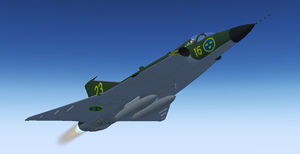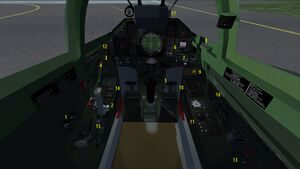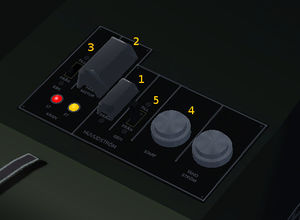Saab 35 Draken
 | |
|---|---|
 | |
 | |
| Type | Fighter aircraft |
| Configuration | Delta-wing aircraft |
| Propulsion | Single-engine jet (Jet aircraft, Single-engine aircraft) |
| Manufacturer | Saab |
| Author(s) | Anders M (3D model, FDM, Cockpit) |
| FDM | JSBSim |
| --aircraft= | SaabJ35F |
| Status | Early production |
| FDM |
|
| Systems |
|
| Cockpit |
|
| Model |
|
| Development | |
| Website |
|
| Repository |
|
| Download |
|
| Forum |
|
| License | GPLv2+ |
|
| |
The Saab J35 Draken (Dragon) is a Swedish supersonic interceptor developed in the 1950s. The model F was delivered between 1965 and 1972 and is the model that the FG plane is based on.
Description of the features
Number in parenthesis refers to the cockpit images.
Special aircraft keys
| Key | Function |
|---|---|
| ⇧ Shift+S | Automatic start sequence including all systems. (The aircraft needs to be stationary.) |
| ⇧ Shift+L | Attach or remove drop tanks on ground. (Stationary and drop tank selector off) |
| Ctrl+J | Jettison drop tanks in air. |
| Ctrl+D | Unlocks and opens/closes and locks canopy. Closed and locked canopy - first press unlocks second opens canopy. Closed and unlocked canopy at simulation start - first press locks. Open canopy - first press closes canopy second locks |
| ⇧ Shift+Q | Fuel cut off, not normally needed. |
| ⇧ Shift+P | Use drag chute handle |
| e | Fire ADEN 30mm cannon (100 rounds available, 1700 rounds per minute) |
| z | Sight ring: Decreased distance |
| ⇧ Shift+Z | Sight ring: Increased distance |
Special indicators
- GLÖM EJ LAND-STÄLL: ("Do not forget landing gear") flashes if altitude < 1450 m, airspeed < 450 km/h and throttle < 85%
- HUVUDVARN.: Main caution light. Indicates important system warnings. See below. Acknowledge by pressing the light to silence the alarm. No warning signal while taxing.
- HÖJDV: Flashes when autopilot HÖJD (altitude hold) is set and aircraft not at target altitude or vertical speed above 200 m/min. Lit when stable at target altitude. It is recommended to be at target altitude before setting autopilot to HÖJD.
- Landing gear down and locked: (LANDSTÄLL LÅST UTE) Green lights front lower left
Gauges and instruments
Fuel gauge
Shows percent of drop-tanks left until they are empty if attached. Otherwise percent of internal fuel remaining. The two needles shows left/front and right/rear tank level. The engine is supplied by the two tanks alternating if not on afterburner, therefore the needles will chase each other down the scale.
G-gauge
Max G-force is displayed by a striped needle. Reset by clicking the small reset pin on the right side of the instrument.
Altitude gauge
Pressure setting is done by clicking left or right side of the setting knob (lower left of he instrument).
Altitude selector
Right side below secondary AI. Sets target altitude for autopilot. (7). Click for PLANÉ mode.
Course selector
Below Heading indicator. Sets course needle on the heading indicator (compass).
Clock
Clock ring: Knob furthest right from clock turns the ring. Set pointing to the minute hand before lift off to keep track of flying time.
Clock mode button: Lowest knob. Switches between clock and stopwatch. In reality also setting of the clock but not implemented.
Stopwatch button: Starts, stops and resets the stopwatch.
AHK
The real AHK (swe.Avstånd Höjd Kommando, eng. distance altitude command), on the right side of the radar, was an instrument connected to the Swedish air combat control centres (The system is part of "STRIL60"). It gave tactical information to the pilot by 20 different commands, displayed as words at the top of the instrument, and also by the distance scale and the arrow needle on the height scale. Some of the commands are reused as instrument modes.(6)
In all modes the "HÖJD" (altitude) scale shows pressure-altitude. Dot-needle from 0-2000 m and tape-needle from 0-20000 m.
Modes:
- 0: (Off) Only altitude shown
- HÖJDÄNDRING: Arrow shows height reached in one minute at current vertical speed. Scale 0-20000 m. "AVST" tape shows distance over ground to change altitude 1000 m at current vertical speed. Speed over ground calculated from IAS using standard atmosphere.
- LANDA: Arrow shows height reached in one minute at current vertical speed. Scale 0-2000 m.
"AVST" tape shows distance over ground until tuchdown at sealevel and current vertical speed. Speed over ground calculated from IAS using standard atmosphere.
- AVST. 400: Arrow shows height reached in one minute at current vertical speed. AVST tape shows distance to beacon 0-400 km.
- AVSTÅND 40: Arrow shows height reached in one minute at current vertical speed. AVST tape shows distance to beacon 0-40 km.
- BARBRO: Arrow shows height reached in one minute at current vertical speed, scale 0-2000 m. AVST tape shows distance to beacon 0-40 km.
- NYTT MÅL: Arrow shows Route Manager cruise altitude 0- 20000 m. AVST shows distance 0-400 km to next Route Manager waypoint.
Caution panel
Lower right.(9) Shows system cautions and warnings. Those with ! in front triggers main caution light:
- !BRAND MOTOR: (fire engine) not implemented
- !BRAND EBK P: (fire afterburner pump) not implemented
- !STYR AUT: (autopilot) autopilot off
- MOTOR IS: (engine ice) engine deicing on not implemented yet
- !TANK LUFT: (tank air) airpressure fault in fuel system. Not implemented
- !OLJE TRYCK: (oil pressure) low oil pressure.
- EBK: (afterburner) Indicates that the exhaust nozzle is working as AB is turned off or on
or open when idle on the ground to keep engine from overheating. (Not lit constantly when using AB.)
- !SYR GAS: (oxygen pressure) not implemented
- !EL FEL: (electric fault) fault in AC circuit or generator off.
- !HYDR I, HYDR II: (hydraulic I and II) Low pressure in hydraulic circuit
- !KABIN TRYCK: (cabin pressure) Cabin pressure too low. Not implemented.
- !HUV LÅS: (canopy lock) canopy not locked.
TANK LUFT, OLJE TRYCK, EL FEL, HYDR I and HYDR II will be lit when generator off. But should go off during engine start up.
Radar
Only a limited simulation of the radar is implemented:
- Showing a sweep and antenna azimut. (mode TYST and SÄND)
- In multiplayer the radar shows aircrafts in radar range: dist < 40 km, +-60 deg in yaw, +-30 deg in pitch and > 100 m above ground. (mode SÄND)
Radar Modes. Set by radar panel on the right side of cockpit(16):
FRÅN: Power off
BER: Readies radar for transmission. Takes 20 sec (In reality 3 min)
TILL: Like BER but sights and weapon connections also ready. (Same as BER in the simulation.)
TYST: Everything running but no emissions from antenna.
SÄND: Everything running and antenna emitting.
Yellow lines are navigation indicators used by the navigation system. See below.
Knobs on radar panel set intensity of scope (LJUSSTYRKA FSKOP) and navigation lines (KORSVISARE).
Radio The radio equipment consists of two transceiver and one control unit of model Fr-21. They are on the left horizontal panel. In the simulation both transceivers are used for communication. In the real aircraft one was the receiver for combat control data feeding the AHK and other avionics. The letters A-K stores pre set frequencies for transceiver A (closest to the control unit) and the numbers 1-5 stores pre set frequencies for transceiver B. A stores the COM1 frequency at FG start up. Number 1 stores the COM2 frequency at FG start up. The frequency for the other letters and numbers are in the text file $FG_HOME/Export/SaabJ35F-Fr21.txt and can be changed by the user. Pressing the buttons marked with dash (-) makes it possible to manually set the frequency using the knobs on the two manual units. Changing mode from Normal to Reserv changes sending unit from A to B. The radio is off at simulation start. Transceiver B uses battery power and transceiver A uses main AC.
Autopilot
The autopilot is on the right side of the seat (11) and has the following functions and controls:
- HÖJD: Altitude hold. If plané on altitude selector the autopilot will folow a glide slope of approx 3 degrees.
- ATTITYD: Attitude hold- pitch and roll
- DÄMPN: Pitch and yaw-damper on. This is on in all normal flight conditions
- SVÄNG: Banks the aircraft in attitude mode
- NOS: Pitch setting in attitude mode
- FRÅN TILL: Main autopilot switch. Normally left on. Triggers caution light if off.
- ROLL: Roll trim elevon setting
- GIR: Rudder trim setting
- Middle mouse button zeros the slider/knob.
IMPORTANT: The autopilot has an automatic switch to only damping if airspeed is Mach 0.95-1.05 or G-force is above 4 G or below -0.5 G. No warning is given.
At present the autopilot is not as stable as it should be, especially altitude hold.
Navigation radio and mode selector
Right side panel below cautions.(10) Main mode selector for navigation, AHK and radar.
Draken does not have ordinary navigation instruments. It has a special system that was integrated in the combat command and navigation system of the Swedish airforce. A letter code was used to select navigation beacons and airbase landing system. There was two parts of the system: Anita - general navigation and Barbro - landing guidance.
To simulate this and still be compatible with FG there is a file beacons.txt in the aircraft's directory. In that file you write a line for each beacon you want to use. The format is a comma separated list: letter code,type,frequenzy,note
- letter code: Three letters A-P that identifies the beacon. Anita (VOR, NDB) does only use the first two (you can set the last to any character you want). Barbro (ILS) uses all three.
- type: VOR, NDB or ILS.
- frequency: The beacons frequency VOR/ILS in MHz, NDB in kHz.
- note: Descriptive note. Must have at least one character.
The selected mode sets input to course needle (cn), radar and AHK:
- FRÅN: (Off) No nav radio, AHK 0, cn manual, Radar lines parked.
- FÖRV: (Preselected) No nav radio, AHK HÖJDÄNDRING, cn manual, Radar lines parked.
- STRIL: (Combat control) Activates Route Manager, AHK NYTT MÅL, cn direction to next waypoint, Radar lines parked.
- STRID: (Combat) No nav info, AHK HÖJDÄNDRING, cn manual, Radar lines parked.
- NAVRIKTN: (Navigation direction) Uses NDB/VOR set by the two letters NAV. Radar shows direction line, AHK HÖJDÄNDRING, cn ADF.
- NAV 400: (Navigation 400 km) Uses VOR/NDB set by the two letters NAV. Radar shows direction line, AHK AVST. 400 (shows 0 if NDB), cn direction to VOR. In plané mode a glideslope will also be shown on radar.
- NAV 40: (Navigation 40 km) Uses VOR/NDB set by the two letters NAV. Radar shows direction line, AHK AVSTÅND 40 (shows 0 if NDB), cn direction to beacon. In plané mode a glideslope will also be shown on radar.
- LANDN 40: (Landing 40 km) Uses ILS set by the three letters. Radar shows direction line and glide path, AHK LANDA, cn direction to ILS beacon.
- BARBRO: (Barbro) Uses ILS set by the three letters. Radar shows direction line, AHK BARBRO, cn direction to ILS beacon.
Important controls and switches
- Drag chute handle: (BROMSFALLSKÄRM) Lower left.(15) First use deploys drag chute. Second drops it. It takes approx. 3 seconds to deploy and should be done under 320 km/h and above 200 km/h. The handle can not be used if throttle above 85%.
- Throttle: (GASKRAN) lower left.
- Landing gear: (LAND-STÄLL) lower left.
- Droptank fuel valve: Right front canopy rim.(8) Set to on (forward) when using drop tanks.
- Parking brake: Center console below instrument panel to the right.(5)
- Jettison droptanks: Left side with red protection ring.(4)
- Canopy handle: Left side(3)
- Landing light switches: (LAND TAXI) Left front canopy rim.(12) Left and right landing light. If switches are in on position the lights will be automatically turned on/off as landing gear are lowered/rised.
- Navigation lights: (LANTERNOR) Right aft panel.(13) Four settings off, bright, blinking and dim.
- Indicator lights: (IND. LAMPOR) Sets full or half intensity of indicator lights and caution panel,
- Instrument lighting: (INST-LYSE) Left side above throttle. (1) Sets the brightness of the red instrument lighting.
- Consol light: (KONS_LYSE) Left side above throttle.(1) Sets the brightness of the consol lights illuminating the left and right consols.
- Cabin light: (KABIN LYSE) Left side above throttle.(1) Turns cabin light on or off.
- Clock ring: Knob right of clock turns the ring. Set pointing to the minutehand before lift off to keep track of flying time.
- Start panel: Lower left instrument panel.(2) Se below.
Weapons and sight
ADEN 30 mm cannon implemented. Choose AKAN with weapon chooser knob. Right side radar panel(16). If AKAN is selected a gyroscopic gun sight is projected. Use knob on the sights right side(17) to set target wing span and keyboard controls (z/Z) to adjust ring diameter. Nose wheel needs to be up for weapons to function.
Flying
Starting the aircraft
Either press Shift-S and let the automatic start make the work or follow the check list below.
- Battery switch on. The smaller covered switch on the start panel.(no. 1) Click cover to open and then switch.
- Lock canopy. Click handle. The HUV LÅS caution should now go out.
- Turn on main fuel pump. Under the large cover on he start panel.(no. 2)
- Turn on afterburner fuel pump. Leftmost switch on the start panel.(no. 3) The red light on the start panel is now off.
- Turn on drop tanks fuel valve. The yellow light on the start panel is now unlit.
- Press START button on the start panel and wait until the engine is ignited.(no. 4)
- Switch on the generator when engine at 30%. The switch next to the start button.(no. 5)
All caution lights should now be unlit in a few seconds.
Normal operations
- Draken has elevons, combined ailerons and elevators. Large elevon deflections decreases the available aileron difference.
- The aircraft has non-linear control response in elevation to lessen effect of small stick movements.
- It is neutral in roll at low alpha. Keep an eye on the horizon.
- To avoid accidents on landing is it not possible to retract landing gears if throttle < 90 %
- Rotation 270 km/h
- Max airspeed(Vne) 1350 km/h. Max speed with gear extended 500 km/h.
- Touch down speed ca. 300 km/h. 12 degrees AoA
- Too long with negative G causes fuel starvation.
- Watch alpha and speed. Drag increases fast with increasing alpha and pitch can occur at alpha > 25 deg
Lift off: Rotate at 270 km/h to 10-12 degrees pitch. Lift off at approx 300 km/h. Turn of afterburner at 500 km/h if not needed for climbing. Normal climb speed Mach 0.9.
Landing: Lower speed to 500 km/h. Lower gears and turn on landing lights. Turn to final lowering the speed to 325 km/h. Keep a speed of 300 km/h and a plané of 3 degrees (100 m at 2 km distance), RPM 80-85%. After touchdown raise the nose up to increase drag until speed is 240 km/h. Apply brakes. Lower nose at 160 km/h.
External link
- Saab 35 Draken (Wikipedia)
| |||||
